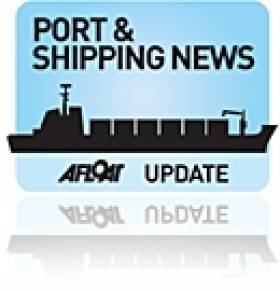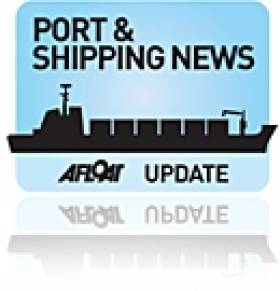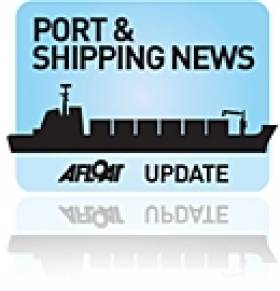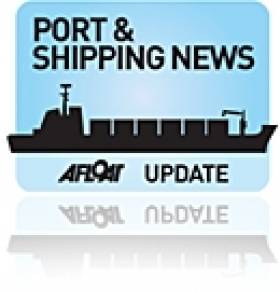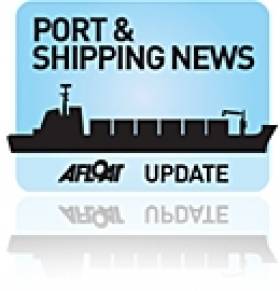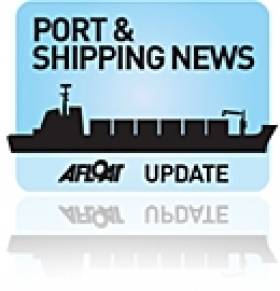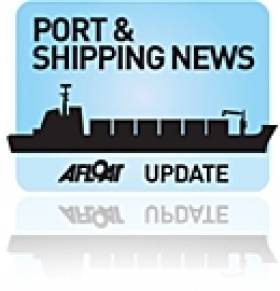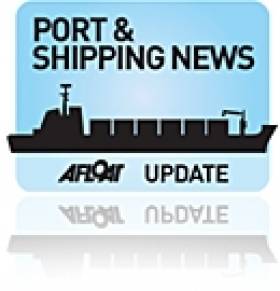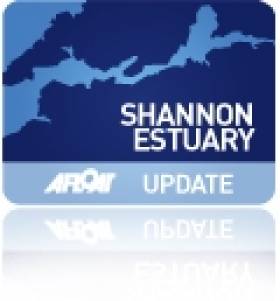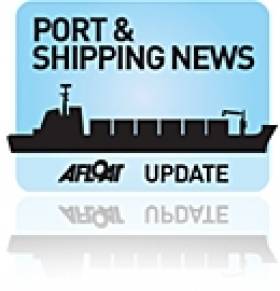Displaying items by tag: Ports and Shipping News
Isle of Man New Operator to Miss March Deadline
#ManxLink - According to BBC Isle of Man,Elann Vannin Line which attempted to establish a ferry service between the Isle of Man and England has confirmed it will not be able to start in March.
Owners of Ellan Vannin Line, Sea Alliance, announced its plans last year, stating it would be an "alternative to the existing monopoly".
All island operations are currently handled by the Steam Packet Company.
Sea Alliance head Kurt Buchholz said he had submitted an application to the Manx government but heard nothing back.
Ports & Shipping Review: Bantry Harbour Takeover, Enter ‘Epsilon’, Storms Disruption and New Shipping Bill
#ShippingReview - Over the last fortnight Jehan Ashmore has reported from the shipping scene where the Cork Port Authority proposes to take-over the Bantry Harbour Board on 1 January 2014.
Irish Ferries chartered ro-pax ferry Cartour Epsilon made her commercial maiden voyage between Holyhead and Dublin Port.
Storms force winds and gales disrupted Christmas travel plans as ferry services mostly operated by fast-craft were cancelled on Irish Sea routes.
Minister for Transport, Leo Varadkar TD announced the publication of the Merchant Shipping (Registration of Ships) Bill 2013 to enhance maritime legislative and safety of maritime transport.
Ardmore Shipping Announce Acquisition of ‘Seafarer’ Sister
#NewTanker – Ardmore Shipping Corporation have acquired a 45,726 Dwt MR product tanker built in 2006 at Minami Nippon Shipbuilding Co., Ltd., Japan, for a purchase price of approximately $20.5 million.
According to EON News, the medium-range vessel is expected to be delivered to Ardmore in December 2013, and is intended to be employed either in the spot market or on a one-year time charter. The company plans to convert the vessel to Eco-Mod shortly after delivery.
Afloat.ie adds that the newly acquired vessel understood to be named Ardmore Seamaster will raise the Ardmore fleet to 21 vessels: nine in operation and 12 on order from three shipyards with deliveries commencing January 2014.
As previously reported the Ardmore Seafarer (2004/45,744dwt) which was completed as Zoa Express, was re-named in honour of seafarers in recognition of 2010 as the International Maritime Organisation (IMO) Year of the Seafarer.
Notably in that same year the crew of the Ardmore Seafarer came under the threat of pirates 1,000 nautical miles off Somalia and some 500 nm off the coast of India.
Ports & Shipping Review: Ports Up 11%, Shortlist for EPSO Award,Short Sea Profit by 2020, Irish Ship May Reopen Channel Islands Service
#ShippingReview - Over the last fortnight Jehan Ashmore has reported from the shipping scene, where shipping and port activity rose up 11% in the second quarter of 2013 when compared to the corresponding period of 2012.
Five European ports; Antwerp, Cartagena, Dover, Livorno and Olso have been selected for the shortlist of the European Sea Port Organisation's (ESPO) Award on Societal Integration of Ports.
Europe's Short-Sea operators are predicted by Dutch consultancy Bloem Doze Nienhuis to have another six years of struggle before returning to profitability by 2020.
Following the demise of Huelin Renouf Shipping in August, a new UK based company is planning to replace the freight service between the Channel Islands by operating an Irish-flagged cargoship.
IMDO Shipping Review: Trade Surplus Increase, ShortSea No Profit to 2020, Old VLCC Values Rise and more
#Ports&Shipping –The latest IMDO Weekly Shipping Market Review includes the following stories as detailed below.
Irish Economy: Growing trade surplus - Trade figures published by the CSO, indicate that the seasonally adjusted value of Irish exports increased by 3% in July, to just over €7.33bn.This, together with a 2% drop in the value of imports to €4.12bn meant that Ireland's seasonally-adjusted trade surplus grew by 8% to €3.21bn.The surplus had been gradually declining over the previous three months, having gone from €3.6bn in March to €2.96bn in June.
Short Sea Market: No profitability till 2020 - Europe's shortsea operators are predicted by Dutch consultancy Bloem Doze Nienhuis to have another six years of struggle before returning to profitability.
Their report suggests that supply and demand for shortsea remains unbalanced, with profitability not returning until 2020. The study of the main operators shows a cargo demand of around 1.8bn tonnes between 2005 and 2012, with the shortsea fleet increasing by 20% to 47m dwt. In 2012 and the first half of 2013 freight rates reached new all-time lows.
Tanker Market: Old VLCC values rise -The incentive to scrap older VLCCs has decreased after Japan'sNYK line sold a 14-year-old 281,050dwt VLCCfor $21m, a large increase on its current scrap value.By contrast, in late July,OSX Leasing Groupsent a 1995-built, 301,862dwt tanker to Pakistani shipbreakers for $16.6m.
For more on each of the above and other stories click the downloadable PDF IMDO Weekly Markets Review (Week 37). In addition to Afloat.ie's dedicated Ports & Shipping News section.
Five European Port Heritage Projects Shortlisted for ESPO Award
#HeritagePorts – What do the following five European ports; Antwerp, Cartagena, Dover, Livorno and Olso share in common?
The answer is that they have been selected for the shortlist of the European Sea Port Organisation's (ESPO) Award on Societal Integration of Ports.
The jury shortlisted the five port applications from a total of 14 submissions for the fifth edition of the ESPO Award. The theme of this year's competition is 'Heritage', because societal integration of ports also means focusing on the contemporary use and disclosure of port traditions.
The public interest in heritage has increased considerably in recent years and has gained strong tourist potential. Most ports boast rich collections of industrial and other heritage, including equipment, buildings and monuments.
This potential can be used in an innovative way not just to explain a port's history, but also to make the connection with present and future development. The iconic value and contemporary use of port heritage can also be employed as a strong promotion tool.
"Many European ports value and cultivate their heritage. Our job was to choose the most exciting projects among a very varied selection of them. Several stood out as particularly creative and visionary. Now we need to choose between them," said jury chairman John Richardson.
The winner of the fifth ESPO Award will be announced on 6 November, during the traditional ceremony that will be held at the Town Hall of Brussels.
The ESPO Award was established in 2009 to promote innovative projects of port authorities that improve societal integration of ports, especially with the city or wider community in which they are located. In this way, the Award wants to stimulate the sustainable development of European ports and their cities.
The shortlisted projects will be presented on the ESPO website in the running up to 6 November.
IMDO Shipping Review: Irish Service Sector Growth, Capesize Rates High, Potential Eco-Ships Savings and much more
#Ports&Shipping –The latest IMDO Weekly Shipping Market Review includes the following stories as detailed below.
Irish Economy: Service sector growth - Fine summer weather, rising tourist numbers and continued signs of a growth saw Ireland's service sector grow at its fastest rate in 6 years in August.
The Investec Purchasing Managers' Index (PMI) measured services sector activity rise from 57.6 in July to 61.6 in August, the highest reading since February 2007 and well above the crucial 50 mark, which denotes that the activity level is expanding.
Bulker Market: Capesize Rates Hit High - The rates for the Capesize market have hit a year high of $19,811 as the Baltic Capesize Index surged 215 points to close at 2,660 last week. Backed by strong iron ore shipments from Brazil, Australia and South Africa into China, daily Capesize rates have risen by $1,957 since 4 September.
Container Market: Potential Savings of EcoShips - Eco designs for container ships could be the cost-saving future and make or break operators. A Hamburg conference has been told that a fuel-efficient design for a 9,000 TEU containership could save $2m a year, enabling it to reduce slot costs.
For more on each of the above and other stories click the downloadable PDF IMDO Weekly Markets Review (Week 36). In addition to Afloat.ie's dedicated Ports & Shipping News section.
IMDO Shipping Review: Irish Manufacturing Improves, Container Fleet Growth,Chemical Tanker Optimism and more
#Ports&Shipping –The latest IMDO Weekly Shipping Market Review includes the following stories as detailed below.
Irish Economy: Manufacturing improves - Irish manufacturing firms saw an improvement in overall business conditions in August as new orders grew at the fastest pace in 14 months, according toInvestec's monthly Purchasing Managers' Index (PMI). The PMI posted a 52 headline figure for August, up from 51 the months before. Anything over 50 indicates growth.
Container Market: Fleet growth continues - The size of the global containership fleet has exceeded the 17m TEU mark for the first time as carriers continue to order larger ships to cut operating costs, figures from Alphaliner showed last week. During the first seven months of the year, a total of 147 ships representing 938,500 TEU were delivered. Total deliveries are expected to exceed1.5m TEU in 2013.
Tanker Market: Chemical optimism - The chemical tanker industry is starting to turn the corner after years in the doldrums, according to Lloyd's List. The global trade in chemicals is heavily dependent on the state of the global manufacturing industry. When manufacturing slows, as has been the case in the last few year, the trade in chemicals suffers, which hits the chemical tanker segment.
For more on each of the above and other stories visit the downloadable PDF IMDO Weekly Markets Review (Week 35). In addition to Afloat.ie's dedicated Ports & Shipping News section.
Shannon Foynes Posts Record Profits
#ShannonPortProfit – Record financial profits by Shannon Foynes Port Company (SFPC) is down to an increase in shipping activity levels not seen since 2008.
SFPC posted an operating profit of just over €3 million for 2012, which after financing costs and net disposal proceeds amounted to just over €2 million.
Operating profit represents a 6.6 per cent rise on 2011 performance. The Irish Times has more on this story.
IMDO Weekly Review: Manufacturing Improves, EU to Ease Port Customs and Prices for Dry-Bulkers Rise
#Ports&Shipping –The latest IMDO Weekly Shipping Market Review includes the following stories as detailed below.
Irish Economy: Manufacturing rises-Irish manufacturing saw its first improvement in four months during June, according to the latest monthly purchasing managers' index, which increased from 49.7 points to 50.3 points. The 50+ reading was largely anticipated, but wider positivity among respondent companies has led commentators to suggest the sector's growth might be sustainable.
EU Shipping Industry: Proposals welcomed -European shipowner and port bodies have welcomed the EC's proposals to ease customs formalities at EU ports, according to Fairplay. The scheme would put the proposals in place as of 2015, as part of an attempt to streamline port functioning to move toward a single EU shipping market. The moves would upgrade further an existing simplified customs regime available to intra-EU shipping lines.
Dry Bulk Market: Vessel prices -Rising prices for second-hand dry bulk vessels point to a turnaround in the industry, according to Market Realist. During May, the average prices for 15-year-old panamax, handymax/supramax, and handysize ships rose to an eight-month high. As companies can sell and purchase 15-year-old ships in the market right away - unlike new builds - price movements in 15-year-old ships reflect market fundamentals.
For more of the above visit the IMDO Weekly Markets Review (Week 27) and also on Afloat.ie's dedicated Ports & Shipping News section.


























